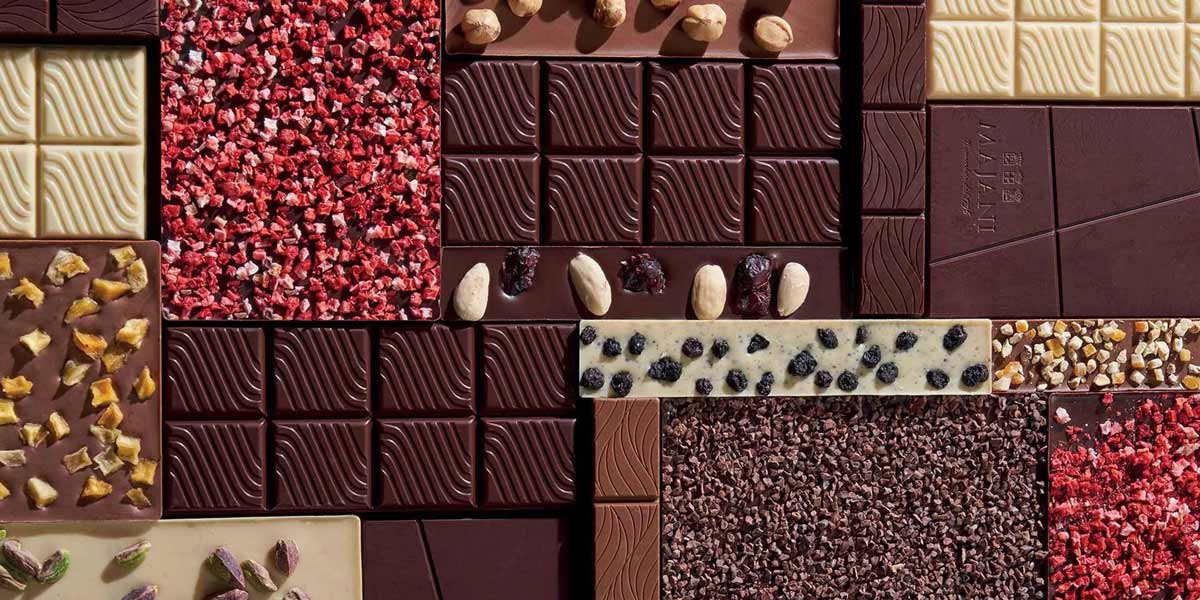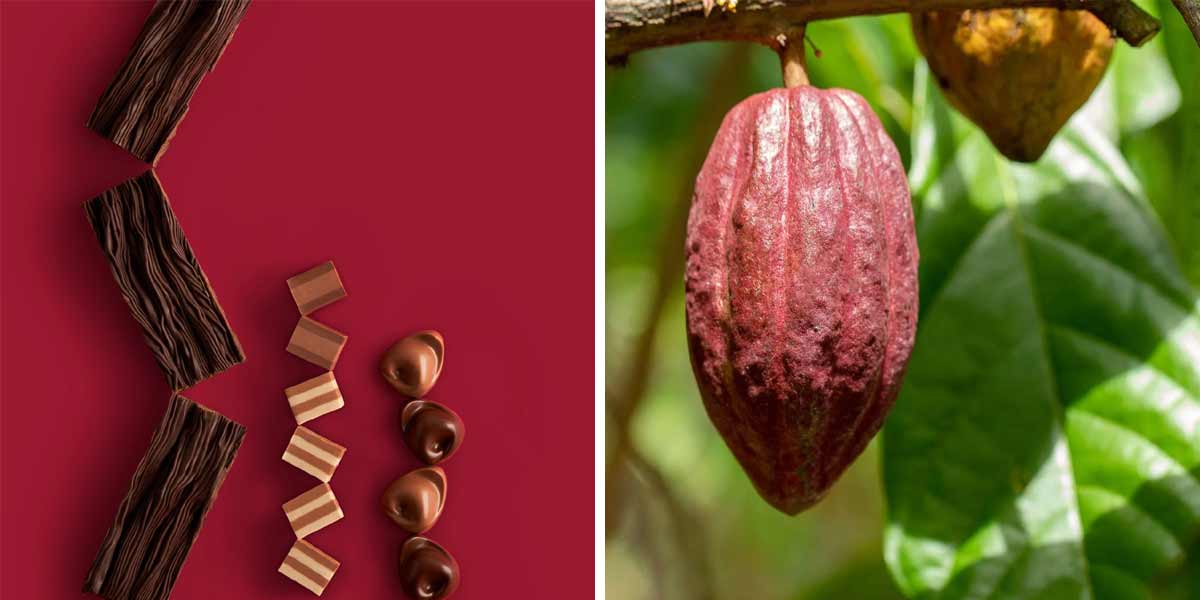Majani Pralines and Chocolate from Italy
Fiat layered pralines, hazelnut, almond, cocoa


Majani, Emilia Romagna is still one of the very few companies that produces chocolate from raw cocoa beans and, as in the past, carries out every single process step in-house. The recipes, handed down over centuries, always preserve tradition and taste.
The cult product from Majani: The internationally known Fiat layered praline not only impresses with its design. It has 4 layers of hazelnut and almond cream.
Majani Cremino Fiat - developed for the Fiat Tipo 4
The most famous name associated with Majani, however, is Fiat. In 1911, Aldo Majani developed the Fiat Cremino for the Turin car manufacturer as an advertising vehicle for the new Tipo 4. This is why the Cremino has four layers of hazelnuts and almonds. This praline is known throughout Italy and everyone who has ever tasted it remembers it.
copyright text: viani.de
Majani - Production
1 Harvest, Fermentation, Drying
After harvesting, the cocoa beans are fermented for 2 to 6 days and then dried in the sun. After a quality control, the beans are packed in jute sacks and transported to our factory. From here, our production process begins.
2 Cleaning and storage
The cocoa beans are first cleaned to remove residues and impurities and then sorted by variety and stored in silos at controlled temperature and humidity.
3 Disinfection and roasting
Before roasting, the cocoa beans are treated with steam to remove any remaining pathogens. The roasting phase is crucial because the controlled cooking of the cocoa beans develops the unique flavors of each variety.
4 Chopping and peeling
The cocoa beans are crushed into small pieces, called grains, and at the same time the skin surrounding them is removed.
5 Preparation of the cocoa paste
By grinding the cocoa beans, mechanical energy is used to liquefy the cocoa butter naturally contained in each bean, giving the product a liquid consistency. This is how cocoa paste is created.
6 Mixing
The necessary ingredients are added to the cocoa mass according to the recipes (icing sugar, roller milk powder, hazelnuts, almonds, vanilla?) Finally, we obtain the actual chocolate.
7 Refining
The chocolate is further crushed to a size of 20 microns, resulting in an extremely silky texture on the palate.
8 conching
The chocolate is conched in special machines called conches, which stir the mixture at controlled temperature and humidity for a variable period of up to 72 hours, depending on the type of chocolate.
9 Tempering
Depending on its quality, the chocolate is cooled and heated to different temperatures to make it easier to work with, shinier and crispier.
10 forms
Tempered chocolate is poured into special molds that shape the chocolate into bars, pralines, gianduiotti, etc. On special lines we produce instead cremini, scorza chocolate eggs and coated fruits.
copyright text: majani.com
Majani - Layered Chocolate - Pralines

copyright photo: majani.com
Majani - Chocolate - Cocoa Bean

copyright photo: majani.com
-

Cremini Fiat Mix, layered chocolates assorted hazelnut cocoa cream, Majani
5,995g € 335,12 * (€ 55,90 / kg)
NOW AVAILABLE NOW AVAILABLE Delivery of the goods within 36 hours of order and successful payment. Please also note the information on payment and shipping.item number: 36815
NOW AVAILABLE Delivery of the goods within 36 hours of order and successful payment. Please also note the information on payment and shipping.item number: 36815 -

Dadino Fiat Mix, layered praline mix hazelnut cocoa cream, Majani
182g € 15,24 * (€ 83,74 / kg)
NOT AVAILABLE Currently not available. When this product will be available is not known. Please also note the information on payment and shipping.item number: 36808
Currently not available. When this product will be available is not known. Please also note the information on payment and shipping.item number: 36808 -

Dadino Fiat Classico, layered chocolates, hazelnut and almond cream, Majani
182g € 15,24 * (€ 83,74 / kg)
NOW AVAILABLE NOW AVAILABLE Delivery of the goods within 36 hours of order and successful payment. Please also note the information on payment and shipping.item number: 36809
NOW AVAILABLE Delivery of the goods within 36 hours of order and successful payment. Please also note the information on payment and shipping.item number: 36809 -

Dado Fiat Mix, layered praline mix hazelnut cocoa cream, Majani
486g € 35,56 * (€ 73,17 / kg)
NOW AVAILABLE NOW AVAILABLE Delivery of the goods within 36 hours of order and successful payment. Please also note the information on payment and shipping.item number: 36810
NOW AVAILABLE Delivery of the goods within 36 hours of order and successful payment. Please also note the information on payment and shipping.item number: 36810 -

Cremino Fiat Noir, layered chocolates with hazelnut cocoa cream, box, Majani
1,013g € 62,62 * (€ 61,82 / kg)
NOW AVAILABLE NOW AVAILABLE Delivery of the goods within 36 hours of order and successful payment. Please also note the information on payment and shipping.item number: 36813
NOW AVAILABLE Delivery of the goods within 36 hours of order and successful payment. Please also note the information on payment and shipping.item number: 36813 -

Centodadi Fiat Classico, espositore, layered chocolates, hazelnut and almond cream, majani
1,013 g € 62,62 * (€ 61,82 / kg)
NOW AVAILABLE NOW AVAILABLE Delivery of the goods within 36 hours of order and successful payment. Please also note the information on payment and shipping.item number: 21415
NOW AVAILABLE Delivery of the goods within 36 hours of order and successful payment. Please also note the information on payment and shipping.item number: 21415 -

Centodadi Fiat Noir, espositore, 100 layer chocolates, nut and cocoa cream, display, majani
1,013 g € 62,62 * (€ 61,82 / kg)
NOW AVAILABLE NOW AVAILABLE Delivery of the goods within 36 hours of order and successful payment. Please also note the information on payment and shipping.item number: 21418
NOW AVAILABLE Delivery of the goods within 36 hours of order and successful payment. Please also note the information on payment and shipping.item number: 21418 -

Centodadi Fiat Caffe, 100 layered chocolates coffee, box, majani
1,013 g € 62,62 * (€ 61,82 / kg)
NOW AVAILABLE NOW AVAILABLE Delivery of the goods within 36 hours of order and successful payment. Please also note the information on payment and shipping.item number: 21420
NOW AVAILABLE Delivery of the goods within 36 hours of order and successful payment. Please also note the information on payment and shipping.item number: 21420 -

Red hearts - dark chocolate m.Cream filling, Fiat Cuori rossi, Majani
2 x 500 g € 54,37 * (€ 54,37 / kg)
NOW AVAILABLE NOW AVAILABLE Delivery of the goods within 36 hours of order and successful payment. Please also note the information on payment and shipping.item number: 21429
NOW AVAILABLE Delivery of the goods within 36 hours of order and successful payment. Please also note the information on payment and shipping.item number: 21429 -

Cremino Fiat Extranoir, layered chocolates, dark chocolate, box, majani
1,013 g € 62,62 * (€ 61,82 / kg)
NOW AVAILABLE NOW AVAILABLE Delivery of the goods within 36 hours of order and successful payment. Please also note the information on payment and shipping.item number: 28046
NOW AVAILABLE Delivery of the goods within 36 hours of order and successful payment. Please also note the information on payment and shipping.item number: 28046 -

Cremino Fiat granellato con pistacchio, light layered chocolates with chopped pistachios, box, majani
930 g € 59,21 * (€ 63,67 / kg)
NOW AVAILABLE NOW AVAILABLE Delivery of the goods within 36 hours of order and successful payment. Please also note the information on payment and shipping.item number: 28049
NOW AVAILABLE Delivery of the goods within 36 hours of order and successful payment. Please also note the information on payment and shipping.item number: 28049 -

Cremino Fiat Classico, layered chocolates, whole milk, box, Majani
1,013g € 62,62 * (€ 61,82 / kg)
NOW AVAILABLE NOW AVAILABLE Delivery of the goods within 36 hours of order and successful payment. Please also note the information on payment and shipping.item number: 36811
NOW AVAILABLE Delivery of the goods within 36 hours of order and successful payment. Please also note the information on payment and shipping.item number: 36811 -

Fiat Mix 10 Dadi, layered praline mix hazelnut cocoa cream, Majani
101g € 11,19 * (€ 110,79 / kg)
NOW AVAILABLE NOW AVAILABLE Delivery of the goods within 36 hours of order and successful payment. Please also note the information on payment and shipping.item number: 39244
NOW AVAILABLE Delivery of the goods within 36 hours of order and successful payment. Please also note the information on payment and shipping.item number: 39244 -

Cremino al Caramel, layered praline. m. hazelnut cocoa cream and caramel, Majani
1,013g € 62,62 * (€ 61,82 / kg)
NOW AVAILABLE NOW AVAILABLE Delivery of the goods within 36 hours of order and successful payment. Please also note the information on payment and shipping.item number: 39438
NOW AVAILABLE Delivery of the goods within 36 hours of order and successful payment. Please also note the information on payment and shipping.item number: 39438 -

Cremino al Sale marino, layered praline. m. hazelnut cocoa cream and sea salt, Majani
1,013g € 62,62 * (€ 61,82 / kg)
NOW AVAILABLE NOW AVAILABLE Delivery of the goods within 36 hours of order and successful payment. Please also note the information on payment and shipping.item number: 39439
NOW AVAILABLE Delivery of the goods within 36 hours of order and successful payment. Please also note the information on payment and shipping.item number: 39439 -

Cremino al gusto di Limoncello Limited Edition, layered praline. m. Hazelnut-cocoa cream, limoncello, Majani
1,013g € 62,62 * (€ 61,82 / kg)
NOW AVAILABLE NOW AVAILABLE Delivery of the goods within 36 hours of order and successful payment. Please also note the information on payment and shipping.item number: 39440
NOW AVAILABLE Delivery of the goods within 36 hours of order and successful payment. Please also note the information on payment and shipping.item number: 39440 -

Ovette granellate, dark and milk chocolate eggs with hazelnuts, Majani
2 x 500 g € 57,77 * (€ 57,77 / kg)
NOW AVAILABLE NOW AVAILABLE Delivery of the goods within 36 hours of order and successful payment. Please also note the information on payment and shipping.item number: 40726
NOW AVAILABLE Delivery of the goods within 36 hours of order and successful payment. Please also note the information on payment and shipping.item number: 40726 -

Ovette Fiat Noir sfuso, dark chocolate eggs with Fiat Noir filling, Majani
2 x 500 g € 64,57 * (€ 64,57 / kg)
NOT AVAILABLE Currently not available. When this product will be available is not known. Please also note the information on payment and shipping.item number: 40727
Currently not available. When this product will be available is not known. Please also note the information on payment and shipping.item number: 40727 -

Ovette Fiat pistacchio sfuso, milk chocolate pralines with pistachio cream filling, Majani
2 x 500 g € 64,57 * (€ 64,57 / kg)
NOT AVAILABLE Currently not available. When this product will be available is not known. Please also note the information on payment and shipping.item number: 40728
Currently not available. When this product will be available is not known. Please also note the information on payment and shipping.item number: 40728 -

Regina 1796 Mix, praline mix. Pistachio cream+dark chocolate+milk chocolate, Majani
2 x 500 g € 54,37 * (€ 54,37 / kg)
NOW AVAILABLE NOW AVAILABLE Delivery of the goods within 36 hours of order and successful payment. Please also note the information on payment and shipping.item number: 40729
NOW AVAILABLE Delivery of the goods within 36 hours of order and successful payment. Please also note the information on payment and shipping.item number: 40729 -

Major Fiat Classico, espositore, layered pralines, hazelnut and almond cream, Majani
60 x 20 g € 81,66 * (€ 68,05 / kg)
NOW AVAILABLE NOW AVAILABLE Delivery of the goods within 36 hours of order and successful payment. Please also note the information on payment and shipping.item number: 40730
NOW AVAILABLE Delivery of the goods within 36 hours of order and successful payment. Please also note the information on payment and shipping.item number: 40730







